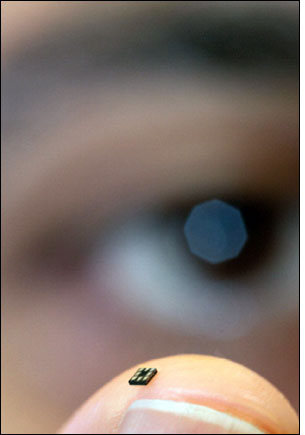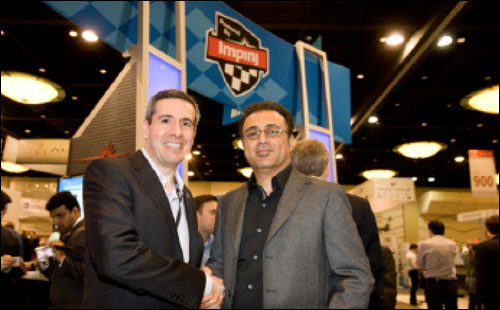Jun 01, 2012Intel Corp. was already the world's largest manufacturer of microprocessors when, in 2005, it began looking for ways to differentiate its products. The company thought it could enhance computer security and functionality by adding a "secure vault" to store a variety of information, such as personal identification and manufacturing records. This April, at RFID Journal LIVE! 2012, Intel introduced a platform that enables a secure vault—and many other applications, from locking electronics devices to deter theft during transit to customizing devices in sealed boxes at the point of sale. The platform promises to have a wide-reaching impact on the consumer electronics industry, from manufacturer to retailer, says Shahrokh Shahidzadeh, senior principal technologist at Intel, who spearheaded the project.
A key feature of the new platform is an ultrahigh-frequency RFID chip embedded in the device's motherboard and wired directly to the microprocessor. The chip is designed with extra memory dedicated to the processor, creating what Intel describes as "processor-secured storage," where data can be stored safely and activated when needed. The data on the chip can be written to or accessed by the Intel processor via an inter-integrated circuit (I2C) interface, which is a semiconductor industry standard, and from an external handheld or fixed RFID reader.

Intel gave the reference designs for the new platform to the hardware vendors that are making Windows 8 tablet computers, which are expected to hit the market later this year.
RFID Inside
When Intel began its secure vault project, RFID was considered mainly a supply-chain technology, but the company recognized that RFID chips were fundamentally memory chips, with an added RF air interface. Intel was looking for a way to add secure memory near the processor to store critical device identification data, and RFID chips emerged as a viable solution. Intel decided if it could add a wired interface to an RFID chip, the chip could be attached to a circuit board and communicate directly with a computer's central processing unit.
The company picked UHF RFID for the project for its relatively low power consumption and long read range. In addition, UHF chip memory can be programmed multiple times. As the project advanced, it became clear that a new chip would have to be created to meet the emerging requirements: The chip had to have memory dedicated to the processor and the ability to access that memory wirelessly. It also had to be scalable, so it could be used in everything from mobile phones to servers.
Intel worked with several semiconductor firms on the initial concept design for the project. For the chip development, the company partnered with Impinj, a Seattle-based maker of UHF chips and readers. The two companies share a common RFID history: In 2008, Impinj bought Intel's RFID division, which included Intel's widely used R1000 RFID reader chip.
A cross-section of Intel employees were involved over the course of the project, including representatives from the engineering, management, manufacturing and supply-chain groups, software architects, radio frequency designers, CPU and platform designers, and security and privacy experts. In addition to the chip and hardware design, software and firmware that enable communication between the processor and the RFID chip had to be developed. Chris Diorio, chairman and CTO of Impinj, also served as a key consultant to the project.

Developing, Testing, Demonstrating
A project of such scope involved a number of obstacles. The engineering and design were complicated. Integrating the antennas proved particularly challenging due to the devices' space constraints. Performance of the RFID chips was affected by the amount of metal in the devices, which limited the read and write range. "It was an underdog project," Shahidzadeh recalls.
Over time, many of the issues were resolved as RFID technology matured and the overall performance of readers and tags improved. As the technology advanced, people began to see new ways it could be put to use. "The performance of chips and readers got better, and the impossibility faded away," Shahidzadeh says. "And as we made progress, possibilities for new uses opened up."
Several groups within Intel helped devise likely scenarios for use of the RFID-microprocessor integration, along with associated business cases and potential benefits. Intel then worked with its technology partners to develop prototypes to demonstrate how the platform would work.
Intel put the platform through vigorous testing to prove that the integration of the chip and the antenna could work within the small form factor of a portable computer. The company built thousands of tablets to demonstrate the concept to customers, retailers and other end users. Windows and Android software developers also used the prototypes to incorporate RFID functionality into their application stacks.
Nearly two dozen potential uses for the platform have been identified for further development and review. With the chip connected directly to a microprocessor, RFID can be used in entirely new ways, Diorio says. "Typically, when people think of UHF RFID, they think of identifying pallets and boxes. The concept here is that RFID can communicate directly with the device that is hosting it—with the microprocessor of a PC, a tablet computer or mobile phone—even when the power is off," he says.
Benefits Throughout the Value Chain
How much impact the processor-secured storage will have on the consumer electronics industry—and Intel's bottom line—will be determined during the months and years ahead, as tablets and other products containing the new chips hit the market. Intel maintains its customers and other supply-chain partners will soon be adapting their distribution and retail processes as a result of the chip's capabilities. Device makers and retailers, for instance, will be able to reduce the number of unique product configurations they stock, because they'll be able to customize applications and other features at the point of sale by sending code to the chip via an RFID reader, based on the specifics the customer wants. The upshot: lower supply-chain costs and higher customer satisfaction, Shahidzadeh says.
Manufacturers will be able to use radio frequency signals to "lock" the devices before they are shipped, rendering them useless and thus a less attractive target for theft. Under this scenario, a tablet or other device could be programmed during manufacturing to be in a sort of digital coma until it receives an activation code from an RFID reader at the checkout counter in a retail store. If a consumer has a tablet shipped to a home or office, the device could be activated by downloading a line of code from an e-mail message sent by the manufacturer. Alternatively, the chip's memory could store a key that would enable partial functionality, so the tablet could be used to demonstrate limited features. And then, once the device receives the activation code, it would be fully operational. This same feature could be used to activate software applications and other services. In addition, warranty and repair information could be recorded on the chip, providing the product's life-cycle history.
The chips also open the door to location-based access control, which means permissions to use particular documents or files can be determined by where the machine is being used, once the identification stored in the chip's memory is authenticated. A bank, for example, could limit access to sensitive customer documents by making them available only in certain locations—an employee would not be able to access customer records on a notebook PC or tablet while sitting in Starbucks, for instance, but could get into the files from designated bank offices.
Shahidzadeh envisions a time when every electronic gadget or portable computing device will have new features and capabilities thanks to the RFID chip embedded in its circuit board. "This is something every electronic device should have," he says. "It has unlimited possibilities."
